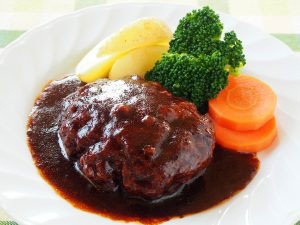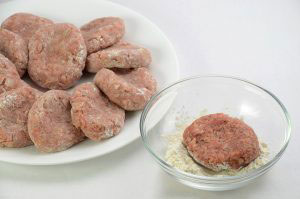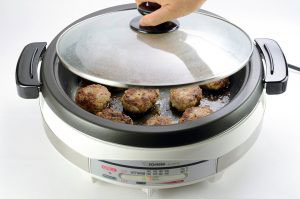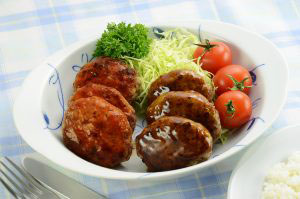“Haan-baa-ghu”.
It’s delicious. It’s uniquely Japanese. And it’s not a hamburger!

Our Foreign Food this month is a delicious Japanized version of steak, with similarities to Salisbury Steak, Steak Tartare and the Hamburg steak from Germany. Hanbāgu is a ground meat patty made from beef and pork, served like a steak, topped with a sauce and typically accompanied by rice and vegetables. This type of chopped meat steak became popular in the United States in the late 1800s, when German immigrants from Hamburg came to live in American cities like Chicago and New York. They made a “steak” with chopped beef mixed with onions, garlic, salt and pepper and cooked until tender and juicy.
Eventually, these steak patties were adapted to be eaten between two pieces of bread, creating the modern American hamburger, and both the chopped beef steak and hamburger were brought to Japan during World War II with the influx of foreign soldiers into the country.

Hanbāgā evolved to become Japanese hamburgers – beef patties served with various toppings served in a bun. Hanbāgu evolved as a rich and savory steak dish, cooked by countless Japanese home cooks, becoming a favorite dish among children and adults.
Hanbāgu is made with a blend of beef and pork called aibiki. This mixture is commonly mixed at a ratio of 7:3 and is typically found prepackaged at Japanese stores. Into the meat are added sautéed onions, egg, panko breadcrumbs, milk, salt, pepper and nutmeg. The mixture is mixed by hand into a gruel-like consistency and formed into patties. The Japanese technique of forming the patties adds a special touch to the meat. The patties are tossed back and forth in the hands, removing air pockets and then indented on the middle to foster even cooking. The patties are also rested in the refrigerator prior to cooking, allowing the slow absorption of flavor from the seasonings.

Once the patties are ready to cook, they are pan fried, instead of grilled, similar to a steak. Red wine or another liquid can be added to the par-cooked patties, and they’re finished covered, having absorbed the liquid for extra flavor.
Traditionally, hanbāgu is served topped with a demi-glace sauce, but a red wine reduction or other savory sauce is also commonly served along with rice and vegetable accompaniments.

Hanbāgu is such a cultural staple and easy to make using our electric skillets. Try our Mini Hamburger recipe for your bentos, and share your favorite way of enjoying hanbāgu!
Leave a Reply